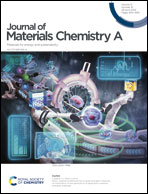In situ construction of an ultra-thin and flexible polymer electrolyte for stable all-solid-state lithium-metal batteries†
Abstract
Solid polymer electrolytes (SPEs) with low density, high flexibility and excellent processability have been attracting broad interest in constructing high energy density and safe all-solid-state batteries. However, the poor lithium-ion (Li+) migration kinetics should be addressed before their large-scale applications. Reducing the thickness can efficiently shorten the Li+ diffusion distance and time, making the low ionic conductivity of electrolytes still applicable for practical applications. Herein, by integrating polyethylene fiber (PEF) with an in situ polymerized network, i.e., poly[(poly(ethylene glycol) methyl ether methacrylate)-r-(vinyl ethylene carbonate)-r-(dimethyl aminopropyl methacrylamide)-r-(polyethylene glycol dimethacrylate)] (PPVD), an ultra-thin, flexible and mechanically robust SPE with a thickness of ≈5 μm was developed. With an ionic conductivity of 2.0 × 10−2 mS cm−1, such an in situ constructed ultra-thin SPE still exhibits a high ionic conductance of 0.1 S, providing sufficient Li+ conductance for operable batteries at room temperature. As a result, the assembled Li|PPVD@PEF|Li symmetric cell delivers stable cycling performance over 800 h. The Li|PPVD@PEF|LiFePO4 full cell exhibits excellent cycling stability with a capacity retention of 85.7% over 500 cycles. The current design of the in situ constructed ultra-thin SPE not only decreases the electrolyte/electrode interfacial resistance but also sheds light on breaking the bottleneck of ionic conductivity for SPEs towards high energy density batteries.

- This article is part of the themed collection: 2024 Journal of Materials Chemistry A HOT Papers


 Please wait while we load your content...
Please wait while we load your content...